
Wallabout Market was the second largest market located at Wallabout Bay in Brooklyn, New York City. [1] [2]

Wallabout Market was the second largest market located at Wallabout Bay in Brooklyn, New York City. [1] [2]
Wallabout gained its name from the French-speaking Walloons of Belgium who were the first settlers on the bay in 1624. The bay was a good location for ferry's across the east river to New Amsterdam. By 1884, a wholesale produce, meat and provisions market was in place in Wallabout. While originally in 1884 there was a few wooden stalls for vendors, as the market continued to grow the city of Brooklyn decided they would build a new market with great architectural design. [2]
The halls were constructed in the Dutch Colonial Revival architecture by the architect William Tubby in 1894-1896. The Market was a host to produce, meat, dairy, fish and other food vendors in addition to grocery stores, restaurants and wholesalers. The market is said to have been beautiful compared to other competing markets. [2]
They were demolished during World War II for the expansion of the Brooklyn Navy Yard.
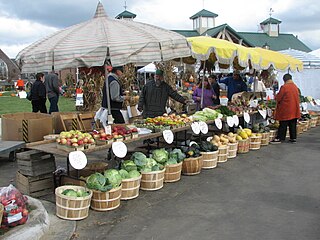
A farmers' market is a physical retail marketplace intended to sell foods directly by farmers to consumers. Farmers' markets may be indoors or outdoors and typically consist of booths, tables or stands where farmers sell their produce, live animals and plants, and sometimes prepared foods and beverages. Farmers' markets exist in many countries worldwide and reflect the local culture and economy. The size of the market may be just a few stalls or it may be as large as several city blocks. Due to their nature, they tend to be less rigidly regulated than retail produce shops.


Reading Terminal Market is an enclosed public market located at 12th and Arch Streets in Center City Philadelphia, Pennsylvania. It opened originally in 1893 under the elevated train shed of the Reading Railroad Company after the city of Philadelphia advocated to move public markets from the streets into indoor facilities for both safety and sanitary reasons.
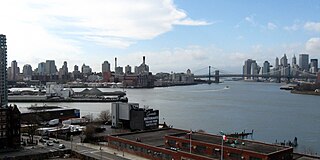
Vanderbilt Avenue is the name of three thoroughfares in the New York City boroughs of Brooklyn, Manhattan, and Staten Island. They were named after Cornelius Vanderbilt (1794–1877), the builder of Grand Central Terminal in Midtown Manhattan.


Dead Horse Bay is a small body of water off Barren Island, between the Gerritsen Inlet and Rockaway Inlet in the New York City borough of Brooklyn.

A marketplace or market place is a location where people regularly gather for the purchase and sale of provisions, livestock, and other goods. In different parts of the world, a marketplace may be described as a souk, bazaar, a fixed mercado (Spanish), or itinerant tianguis (Mexico), or palengke (Philippines). Some markets operate daily and are said to be permanent markets while others are held once a week or on less frequent specified days such as festival days and are said to be periodic markets. The form that a market adopts depends on its locality's population, culture, ambient and geographic conditions. The term market covers many types of trading, as market squares, market halls and food halls, and their different varieties. Thus marketplaces can be both outdoors and indoors, and in the modern world, online marketplaces.
The Brooklyn Eastern District Terminal was a shortline railroad and marine terminal with its main facilities and administrative offices located on 86–88 Kent Avenue in the Williamsburg section of Brooklyn, New York City.

The East Market District, colloquially referred to as NuLu, is an unofficial district of Louisville, Kentucky, situated along Market Street between downtown to the west, Butchertown to the north, Phoenix Hill to the south, and Irish Hill to the east. The area is home to schools, churches, large and small businesses and some of the city's oldest homes and businesses. A destination since Louisville's founding, Market Street has played host to a variety of businesses throughout the city's history that have drawn Louisvillians for generations to its addresses.

Fairway Market is an American grocery chain, founded in 1933 by Nathan Glickberg. It is currently one of the store banners owned by the Wakefern Food Corporation, a company known for its flagship supermarket cooperative network, ShopRite.

The Pratt Institute School of Architecture is located in New York City with courses being taught at Brooklyn and Manhattan campuses. In 2020 the journal 'DesignIntelligence' ranked it in the ten best architecture schools in the United States. Alumni include Pascale Sablan, William Van Alen, Ralph Appelbaum Associates, Annabelle Selldorf, Richard Foster, George Ranalli, Carlos Zapata, and Pritzker Prize winner Peter Zumthor. The School was created in 1928 and by 1954 was recognized as being full degree-granting Undergraduate and Graduate program. Undergraduate architecture is the largest program in both the School of Architecture and Pratt Institute at large with over 550 students. Within the Brooklyn campus, the school of architecture is located a block south of the main campus in Higgins Hall, 61 St James Place.

The Brooklyn Navy Yard is a shipyard and industrial complex located in northwest Brooklyn in New York City, New York. The Navy Yard is located on the East River in Wallabout Bay, a semicircular bend of the river across from Corlears Hook in Manhattan. It is bounded by Navy Street to the west, Flushing Avenue to the south, Kent Avenue to the east, and the East River on the north. The site, which covers 225.15 acres (91.11 ha), is listed on the National Register of Historic Places.
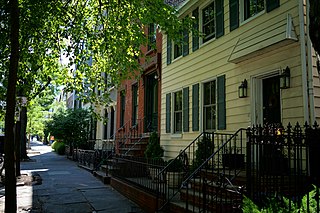
Wallabout is a neighborhood in the New York City borough of Brooklyn that dates back to the 17th century. It is one of the oldest areas of Brooklyn, in the area that was once Wallabout Bay but has largely been filled in and is now the Brooklyn Navy Yard.
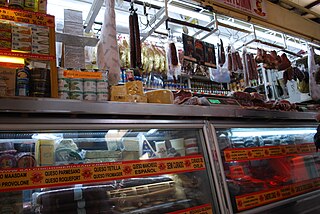
The San Juan Market is a traditional Mexican market in the historic center of Mexico City that has become the city’s only such market specializing in gourmet and exotic foods. It is known for its selection of exotic meats, including venison, crocodile, wild boar and even lion meat, as well as a wide selection of products from Europe and the Americas. Unlike other such markets in Mexico City, it caters to chefs, restaurateurs and foodies, many of whom are foreigners and have long-standing relationships with particular vendors.
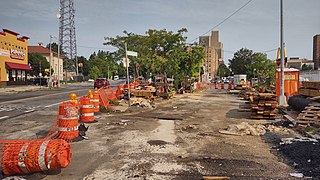
Russell D. Ramsey Triangle, a triangle-shaped traffic median in Brooklyn, New York City, memorializes an individual who devoted his life to the firefighting profession, working out of the nearby New York City Fire Department dispatch station at 35 Empire Boulevard for nearly a quarter-century. This triangle is bound by Empire Boulevard, Washington Avenue, and Franklin Avenue.

Smorgasburg is an open-air food market that originated in Williamsburg, Brooklyn next to the East River. It takes place every Saturday in an empty lot. The name Smorgasburg is a portmanteau of "Smörgåsbord" and "Williamsburg." Dozens of vendors sell their food and wares. It initially was started in 2011, by Jonathan Butler and Eric Demby as an offshoot of Brooklyn Flea. Originally, some businesses were not able to set up at Brooklyn Flea due to limited space, so the founders created a food-centered version of the original market. They chose Brooklyn due to location and affordability of space. The food tends to be small-batch and innovative foods. Smorgasburg grew quickly in popularity and some vendors were able to upgrade to brick-and-mortar locations.
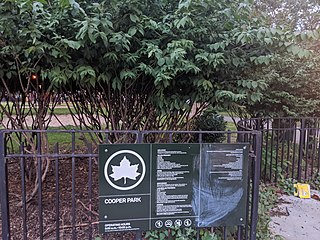
Cooper Park is an urban park in Brooklyn, New York City, between Maspeth Avenue, Sharon Street, Olive Street, and Morgan Avenue in East Williamsburg. It was established in 1895 and covers 6.40 acres (2.59 ha).

Rockwood & Company was a New York City-based chocolatier which operated from 1886 until 1957. It coordinated the industry's first resale price contracts, operated the largest chocolate factory in New York, and was the second largest producer of chocolate in the United States, after the Hershey Company. Founded in the borough of Manhattan, it moved to the Brooklyn neighborhood of Wallabout, gradually expanding its footprint to occupy most of a city block. In 1919, a fire led to a flood of chocolate in the street, attracting a crowd of children. Rockwood & Company sold the factory to the Sweets Company of America in 1957, who used it to produce Tootsie Rolls until it closed in 1967. The Rockwood & Company factory complex was listed on the National Register of Historic Places in 1983, which was later merged into the Wallabout Industrial Historic District. It was converted to luxury apartments in 1996.

{{cite web}}: CS1 maint: url-status (link)40°42′0″N73°58′1″W / 40.70000°N 73.96694°W